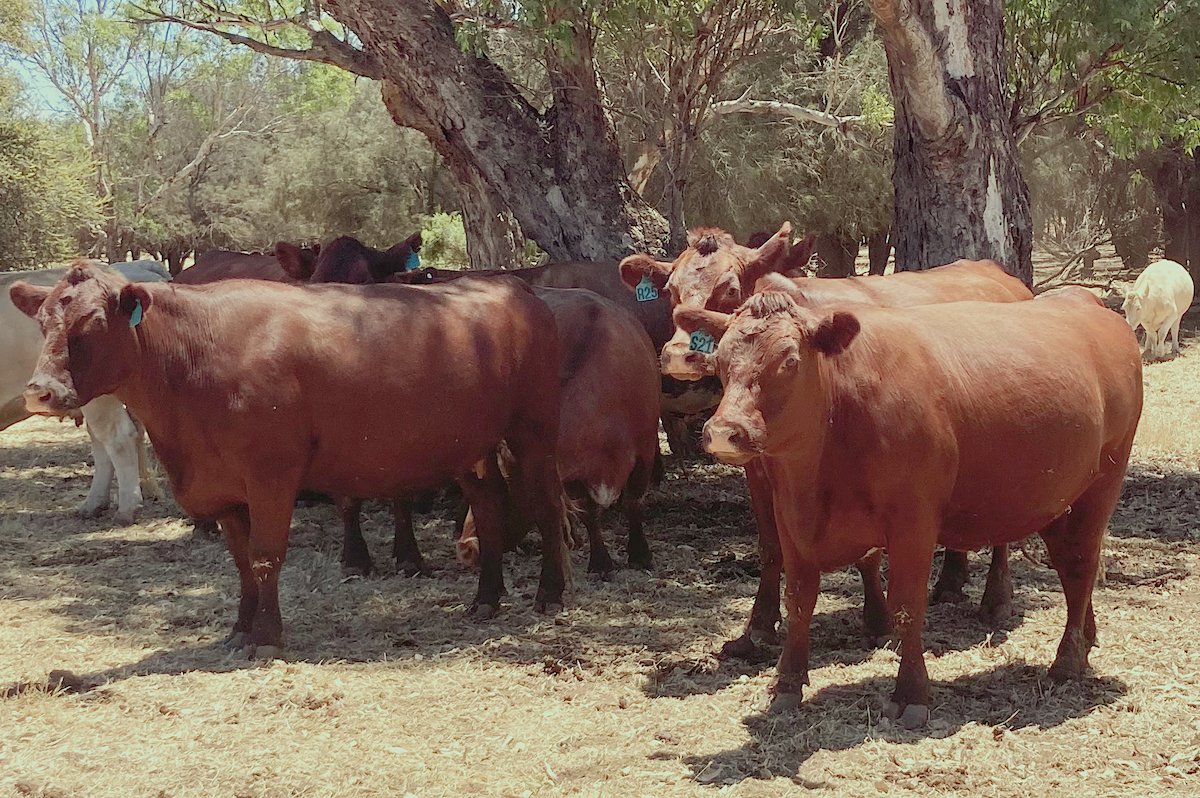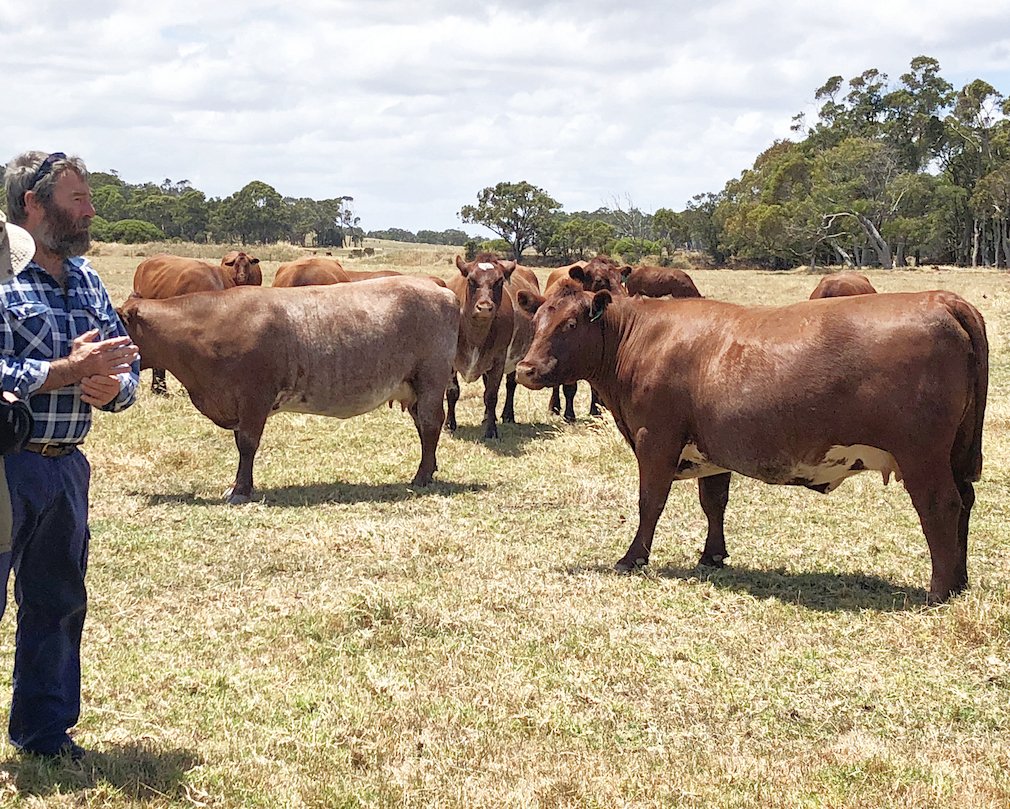Farm Update
Spring has arrived and our pasture conditions are excellent. In fact they are the best in several years. With record high cattle prices here in the USA there is optimism in the air even as we approach the dreaded “political season” this fall that occurs every 4 years. As we continue to produce rare offspring from many of the great Heritage Shorthorn bulls of the past I am encouraged by the burgeoning interest in our herd especially in Canada. Our goal is to continually make available quality, rare Heritage Shorthorn genetics that will increase both the diversity and relevance of the Heritage Shorthorn breed.
Shorthorns in Australia
This is the final article on my numerous trips to Australia visiting different Shorthorn herds over the last 20 years. It is a continuation of the previous Shorthorn Bulletin which discussed Shorthorns in Tasmania.
Western Australia: Geography And Demographics
It is imperative to grasp the enormous variability in the topography of the Western Australia (WA) land mass to fully comprehend why raising Shorthorns in WA is so difficult. For comparison Western Australia is four times as big as Texas and is by far the largest state in Australia encompassing one third of the country. Stretching almost 2,200 miles North to South the huge size of Western Australia engenders tremendous variability in climatic and geographical conditions. The great deserts of Central Australia bisect the country and contribute to the geographical isolation of WA from the rest of Australia. With WA’s low population density (just 11% of the Australian population) the logistics and management associated with cattle production is lacking as evidenced by the fact there are only 2.1 million head of cattle in Western Australia (8.6% of the Australian cattle herd). The demand for cattle, and the infrastructure to support large cattle operations, is wanting.
Western Australian Shorthorn Herds: (A discussion of two individual herds will be presented in the order my wife and I visited them on our latest trip to Australia in the fall of 2023.
Liberty Charolais & Shorthorns
Owners: Kevin and Robin Yost
Location: Toodyay, Western Australia
Kevin & Robin Yost (on left & middle) with Joe & Sue Schallberger (on right)
Located in the “Wheat Belt” of WA the Yost family’s Liberty Shorthorns has emerged as an important new Shorthorn herd in Australia with international aspirations. The herd was started 9 years ago but has made rapid progress in building a top notch Shorthorn herd in Australia through acquisitions and selective breeding. The Yost family has a long history in the purebred livestock industry, and have been breeding purebred award winning Charolais for over 30 years, along with shepherding a flock of 1500 white Dorper ewes for fat lamb production. Kevin actually grew up in Iowa in the Untied States eventually immigrating to Australia through his relationship with Robin. Having grown up in a completely different farming environment in Iowa, Kevin brings a breadth of knowledge and experiences that enhance the farming techniques and skills of the Yost family farming operation. Daughter Morgan is the Stud Manager for the Liberty herds and is actively engaged in all aspects of overseeing the Yost cattle operation.
Shorthorns were added to increase marketing opportunities and balance genetic trait offerings. Currently the Shorthorn cow herd numbers 60 along with 220 Charolais females. Besides private treaty sales, the Yost have an annual bull sale in April each year with many bulls being sold to the Northern Cattle Stations in WA. In contrast to most Shorthorn breeders in Australia, the Yosts sell most of their bulls at a younger age (1-1 1/2 years) trying to provide extra value to their buyers who gain an additional year of breeding from their purchased bulls. They have found this to be a successful marketing tool but requires “management re-education” of buyers to facilitate seamless utilization of the bulls.
Both the Shorthorn and Charolais herds rotate through a pasture management system that is subjected to the vagaries of potential drought conditions that often wreak havoc on grass production in WA. Because of the dry land conditions in their part of WA their cropping consists of oats for hay/silage production and barley for supplemental feeding during the winter and throughout the calving season. Utilizing a minimalist production system enhances the the ability of Yost Shorthorns to work well in all conditions in WA.
All cattle and people are faced with the reality of Australia being home to 7 of the 10 most poisonous snakes in the world. Most rural cattle breeders in Australia carry Snake Bite Kits in their vehicles because of the potential hazards and the fact they frequently live in remote locations. Cattle are often just found dead as they quickly succumb to a poisonous bite. Any large cattle operation in Australia will occasionally lose stock to snake bite. The Yosts have had encounters with poisonous snakes that could have had severe consequences, but fortunately did not. Vigilance is the watch word in Australia as many times I was warned about poisonous snakes being a risk when walking through fields looking at cattle in Australia.
Since my visit in November of last year the Yosts have achieved another milestone as they have sold 10 head of cattle to Botswana. Included in the sale were 2 Shorthorn heifers and 2 Shorthorn bulls. They are to be congratulated in taking their herd to another level, another country, and another continent. This sale exemplifies the reach of Shorthorns and specifically the surging quality of the Liberty herd.
Yost Charolais and Shorthorn cattle
Narralda Shorthorns
Owners: Alec & Heather Burrows Managed by their son: Graeme Burrows
Location: Albany, Western Australia
Started in the 1960’s by Alec Burrows, the Narralda herd has a long and decorated history in Australian Shorthorn circles. Situated just miles from the Southern Ocean coastline of WA, close to the famous tourist town of Albany, Narralda Shorthorns enjoy a more mild, temperate climate compared to most of the rest of WA. Average rainfall is about 35” which allows for good grass production throughout much of the year. The incongruities of the weather conditions, given the proximity to the Southern Ocean, can have an a negative impact but generally does not produce the severe drought conditions that often exist in much of Australia.
Management of the Narralda herd was assumed by the Burrows’ son, Graeme Burrows, in 2017 when Alec elected to retire. During the time Alec controlled the herd, he put an emphasis on showing and selling Shorthorns in many parts of Australia. Showing was part of the mechanism used by Alec to sell his Shorthorns and he was very successful at it. Concurrently Alec pursued the top Shorthorn genetics in Australia, along with occasional usage of AI bulls from outside Australia, to build both quality and competitiveness into his herd’s genetic traits that are still very evident today.
Currently, with Graeme managing the herd (200 Shorthorn cows), emphasis has turned more to the commercial side of the Shorthorn industry. Grass fed genetics that can withstand the inconsistencies of both the Australian weather and forage conditions have become the bedrock of Graeme’s goals with the Narralda herd. His emphasis on growth, temperament, structure, calving ease, and longevity are incorporated into his selection process as he pursues a symbiotic relationship with the commercial cattlemen of Western Australia.
I was struck by the size and shape of many Narralda females, partly because they emulate what I look for in a Shorthorn cow, but also because they hark back to what I call “real Shorthorns” were and should be again. The type that the Shorthorn breed was built on, not the composites and crossbreds, that are the mainstay of most Shorthorns in America today and to a certain extent in Australia.
Graeme Burrows (L.), and Joe Schallberger (R.)
The depth, length, and thickness of many of the cows in the Narralda herd are to be admired, and in my case, envied. The fact these cows were able to achieve this level of quality is a testament to the abilities of both Graeme and his father, Alec, in putting together the “Rubic Cube” of genetics that exists historical within the Shorthorn breed.
Much of what is being achieved in the Narralda herd today can be attributed to the fact that Graeme is one of the few Shorthorn breeders I have ever met that actually uses EPDs correctly. Originally, EPDs were developed for within herd comparisons to self select the best individuals within one’s herd to improve the herd based on the local environment, forage, and management system that is employed. In contrast EPDs are frequently misused in Shorthorns today because of the small sample size, lack of accurate data, and tremendous herd variability in both management and environment. Currently many Shorthorn breeders and Shorthorn Associations use EPDs/EBVs for marketing by trying to convince others to “buy into” the hype. Graeme actually uses an in house software program that his son developed which maximizes his ability to self select using all the different data points he accumulates in his herd on a continual basis such as birth weight, weaning weight, yearling weight, dam longevity, etc. This methodology augments both his phenotype and pedigree information. I was very impressed by his well thought out herd building approach to develop, select, and sell quality Shorthorns to both commercial and stud breeders.
Narralda has an annual production sale that is in either February or March of each year offering a mixture of Stud and Commercial bulls and heifers. Individuals or groups are also sold privately. Steers are marketed at local facilities which decreases transportation costs. Given Graeme’s propensity to both innovate and modify his selection process , I believe the Narralda herd has a bright future. If Shorthorns are going to play a role in the cattle industry long term, then there is a great need for Shorthorn breeders like the Burrows.
Conclusions:
I continually marvel at the dedication and commitment of Shorthorn breeders around the world who want to make Shorthorns great again. My visit to Australia last fall was further proof to me that Shorthorns are definitely the most versatile cattle breed in the world. With the dynamism of the world today, opportunities exist that were never available to Shorthorn breeders before. Seizing on new technology that can be melded with the wide, pure, genetic base of the traditional Shorthorn breed will provide a route forward for the Shorthorn breeders that can be both profitable and personally rewarding.
Future Topic: A.I. Versus AI: Short Changing The Shorthorn Breed?
Joseph Schallberger, DVM, PhD
Whispering Hills Farm
Member Academy of Veterinary Consultants







